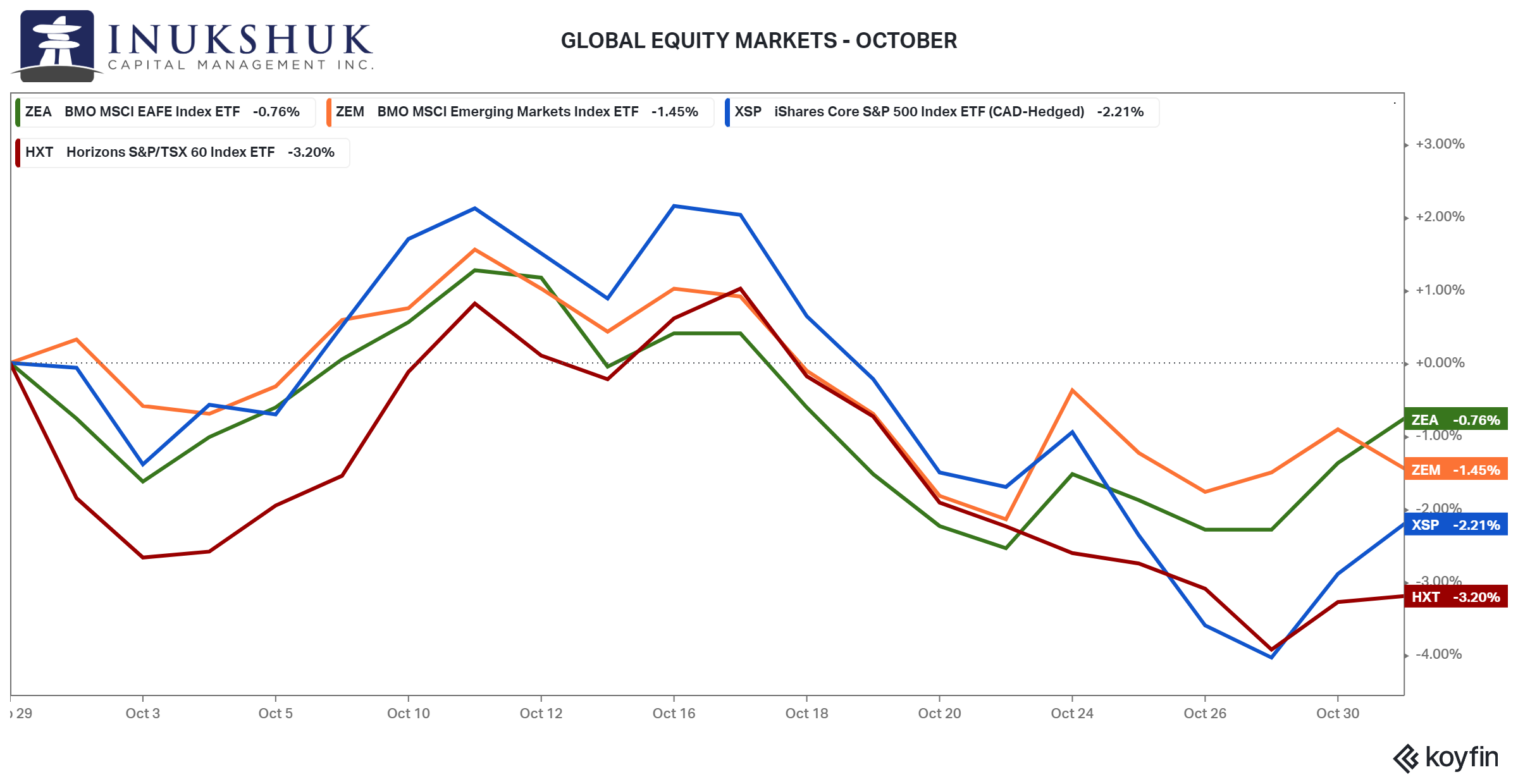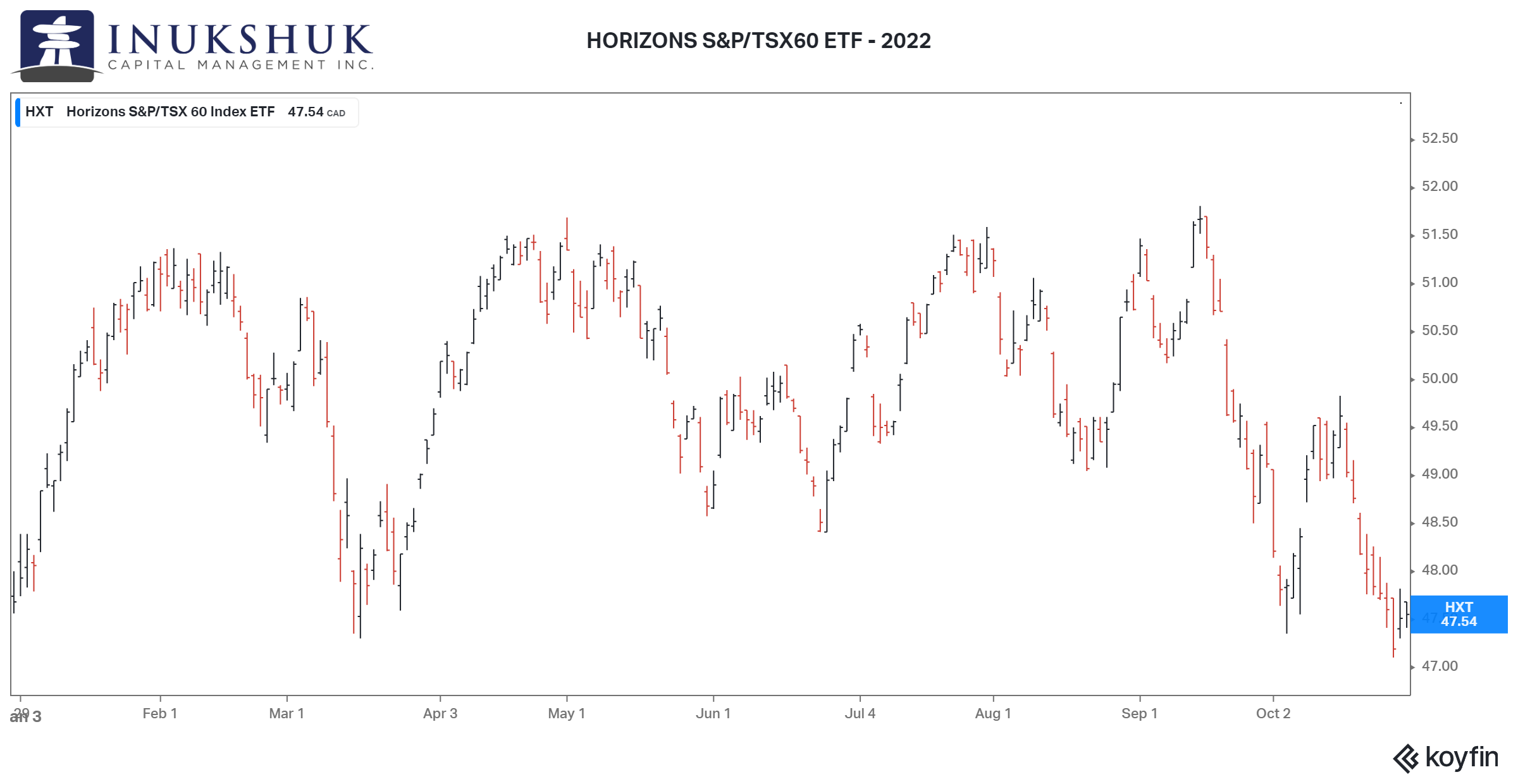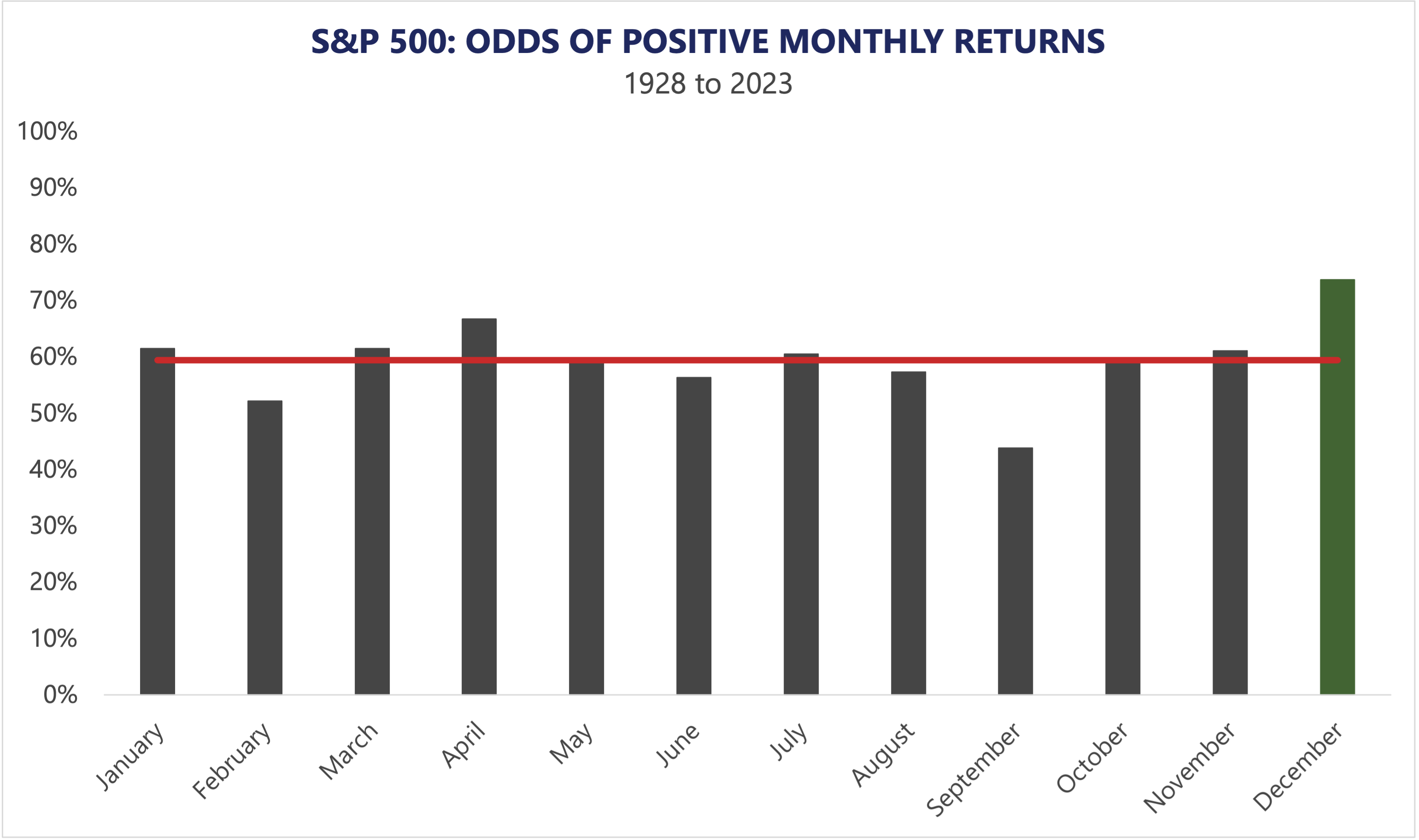We built Inukshuk Capital Management to serve the needs of clients looking for a unique approach – void of conflicts of interest, commission sales and pushed products. We began by putting our own money where our mouth is. With low fees and active risk management, we help families achieve financial longevity, that’s the bottom line.
Stay up-to-date on the latest developments by following us on LinkedIn here.
November 2023: Odds
In this issue:
- Global Equity Market Performance
- Odds
- Santa
- Krampus
- Risk
- Wrapping Up
- Health is Wealth
Global Equity Market Performance
October capped off a three-month streak of miserable equity market performance. All four major market indexes showed a loss. MSCI EAFE was the ‘outperformer’ down 0.76% followed by Emerging Markets 1.5%, the S&P 500 2.21% and the S&P/TSX60 3.20%. Since the end of July the S&P/TSX60 has lost 7.8% of its value.
The S&P/TSX60 has spent the entire year going nowhere fast.
The S&P/TSX60 as represented by Horizons ETF, HXT, closed on December 30, 2022 at 47.67. On October 31 it was 47.54.
Our systems continue to remain fully long the S&P 500 and S&P/TSX60 although the warning signs for Canada continue to persist.
If you would like to stay current on our measures of trend and momentum in the markets we follow, please click here .
Odds
Last month we studied the fall. A question was posed: if September is bad (and often it is) does that mean October will be as well? The answer: not necessarily. The odds of October being up after a losing September are 56%. So much for that. That’s why they’re called odds.
According to various sources the word odds was first used in the context of betting in the 1500s. Its origins are in the Old Norse word oddsmál where odd means point or the tip of a weapon and mál means measure or agreement/disagreement. The pointy stick of disagreement. Makes sense. Note: Old Norse is not our specialty, so this was put together using two different GPTs and several prompts.
Santa
It’s not all doom and gloom however. There is a phrase that has been around stock markets since the 1970s: the Santa Claus Rally. It’s a reference to humans noticing December is a good month for stocks. Since we like numbers let’s see if it is.
Here are the returns of the S&P 500 since 1928.
There are a couple of big wipeouts there. December 1931 at 15% and more recently 2018 was a lump of coal, size 9%. But more times than not, December closes the year with a win. It ranks first with 70.
Here are the odds of each month being up.
December is at 74%. Reminder: see above for the definition of odds.
Krampus
North Americans generally imagine Santa Claus as a jolly bearded man in a red fur coat who flies around dropping off presents for kids who have been nice. The origins of the story are from tales of the generous Saint Nicholas who lived in the fourth century. The Dutch have a similar tradition and called him Sinter Klaas. Apparently, that’s where the name Santa Claus came from.
The interesting thing is that in central Europe Saint Nicholas had an evil sidekick named Krampus. If you were a naughty kid, instead of receiving a gift you got a beating with a stick. It’s not clear if the stick was pointy.
As of this writing, November 8, the S&P 500 is up 4.5% after an eight-day rally. Which is nice. So is this the Santa Claus rally? Nobody knows. Looking at the data, over the past 95 years if November is up the odds for December are 42%. The odds of any month being up are 59%. Keep in mind the month has just started. And these are odds. Nobody knows if Krampus will be riding shotgun this year, but he has 55 times before.
Risk
Our risk measures have been cautious on Canada for several months now – looking at the S&P/TSX60 chart above gives an idea as to why. And they are tightening up for the S&P 500. So we will stick to our systematic discipline regardless of who is zipping around the skies in December
Wrapping Up
The painting above is by artist Mendelson Joe, a Canadian icon who was also a prolific musician. If you want to forget about the Wall Street Waltz (good book by the way) then Google ‘Dance With Joe’ and things will be O.K. (for two and a half minutes).
And, Lest We Forget
Now over to Victoria who explains why this changing of the clocks twice a year can give you the blues.
Health Is Wealth
Navigating the Seasonal Shift – The Impact of Daylight Savings on Health
As a personal trainer and nutritionist, my journey with clients over the years has evolved beyond sets and reps to encompass a holistic understanding of their well-being. Since the clocks turned back, many of my clients have been experiencing fatigue and increased hunger, so I decided to do a little research on this phenomenon.
The post-daylight savings blues, fatigue, and increased hunger can be attributed to the intricate interplay between our internal body clock, or circadian rhythm, and external environmental cues. As we set our clocks back, we disrupt the delicate balance our bodies maintain between sleep, wakefulness, and exposure to natural light. This abrupt change impacts the production of key hormones, such as melatonin, responsible for regulating our sleep-wake cycle. The decrease in natural sunlight exposure during the shorter days can lead to a dip in serotonin levels, affecting mood and contributing to feelings of lethargy—a phenomenon often associated with Seasonal Affective Disorder (SAD). Additionally, alterations in our circadian rhythm can disturb the balance of hunger-regulating hormones, ghrelin and leptin, potentially causing an increase in appetite. In essence, the end of daylight savings initiates a domino effect in our physiological processes, triggering a series of responses that collectively contribute to the blues, fatigue, and hunger during this seasonal transition.
As we prepare for the winter months and adjust to the diminishing daylight, rest assured, there are practical strategies to navigate the accompanying sluggishness and increased hunger. Take advantage of the available sunlight by scheduling outdoor activities during daylight hours; it’s a simple way to boost your mood before winter settles in. Consider the use of a light therapy lamp, a reliable tool to counteract the potential winter blues. When hunger strikes, pay attention to your body’s signals with mindful eating, opting for nourishing meals over quick snacks. Prioritize quality sleep in a comfortable environment to ensure you’re well-rested and ready to face the seasonal changes. Embrace these strategies—welcome the sunlight, get enough rest, and adjust your routines accordingly.
‘You have to sustain it, to maintain it’
Victoria Bannister
ICM Health Ambassador
Have a question? Contact us here
Challenging the status quo of the Canadian investment industry.

















